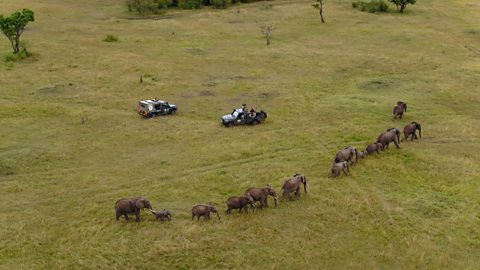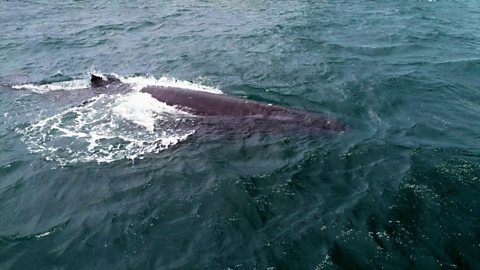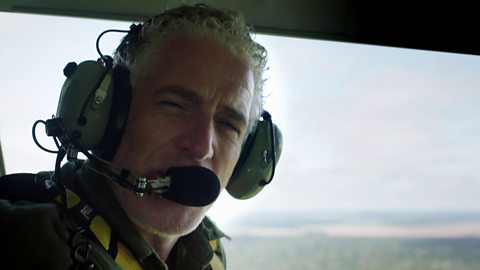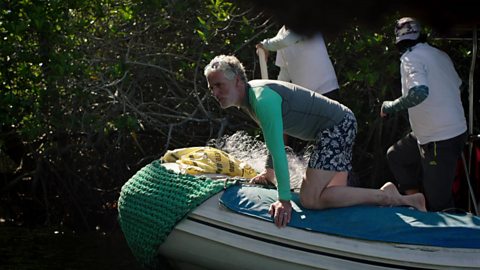Five stand-out moments in Equator From The Air
The equator, a 25,000 mile line that runs around the world, is home to millions of Earth’s species. The area between the tropics is also home to 40% of the world’s people. Here are five of the most staggering moments from the �������� Two series, where wildlife cameraman Gordon Buchanan takes to the skies with scientists, conservationists and law enforcement to highlight some of the equator’s most startling ecological pressure points – and the work being done to protect them.
1. How helicopters help save injured elephants
In Kenya, herds of elephants are running into trouble as they migrate across the Maasai Mara National Reserve along the Tanzanian border. With people increasingly setting up homes on the margins this vulnerable species is fast running out of room to roam.
Farmers and locals often violently attack elephants, frustrated by the crop damage they can cause, and injuries can often be fatal. However, using a helicopter means rangers can find a hurt elephant and have it sedated, treated and back on its feet in less than 45 minutes.

The Mara Elephant Project
Gordon Buchanan joins a rescue team from the Mara Elephant Project in Kenya.
2. Flying drones that can catch a whale’s ‘snot’
Scientists are keeping an eye on the coast of Gabon to see how human activity is affecting the humpback whales that migrate from Antarctica to feed and give birth.
The engine noise from ships can drown out the noises whales use to communicate and pollution can affect their immune systems. To get a handle on it, a research team has to perfectly time a ‘snotbot’ or drone to capture a whale's ‘snot’ – the plume of spray rising from its blowhole. Scientists can then examine the samples to do a health check, looking at whales' DNA, hormones and bacteria.

Snotbot deployed
Dr. Ian Kerr deploys his Snotbot to give a humpback whale and her calf a health check.
3. Seeing the real impact of illegal logging in the Amazon
With the black market timber trade worth up to US $150bn a year, much of it fuelled by European and American demand, more and more rainforest is being cut and destroyed. The timber is laundered by corrupt dealers and almost impossible to trace.
In response, the Brazilian Environmental Police are taking to the air to try and assess how many hectares of the Amazon have been destroyed illegally – and halt the disappearance of the greatest forest on Earth.

Looking for illegal loggers
Gordon’s on aerial patrol with Brazilian police hunting for illegal loggers in the Amazon.
4. Drones used to spot scalloped hammerhead shark nurseries
The scalloped hammerhead shark is in decline. The mangroves in Santa Cruz in the Galapagos Marine Reserve provide safety for the female sharks to give birth and are full of crustaceans the young sharks can feed on.
This endangered species faces many threats including illegal fishing, and no-one knows where the young go after their time in the mangroves. These provide almost impenetrable cover, but tagging the little ones will help conservationists track where they go next and strengthen their case for shark conservation in unprotected waters.
Eduardo Espinoza uses drones to spot hammerhead nurseries amongst the mangroves – and races against the clock to keep each one alive while his team tags them in just 90 seconds.

Baby scalloped hammerhead sharks
Tracking endangered baby scalloped hammerhead sharks in the mangroves of the Galapagos.
5. Assessing the sprawl of Jakarta – a sinking city
Jakarta looks like an incredible feat of modern urbanisation. The population is booming with 10 million living in the inner city and more than 30 million in greater Jakarta. But under the skyscrapers lurks an uncomfortable truth: if things carry on as they are, by 2030 Jakarta is expected to be under water.
Without mains water, its sprawling population has been digging wells into the aquifer, an underground layer of water-bearing permeable rock, gravel, sand or silt, to extract groundwater. With sea water seeping up below the paving of 250 sq miles of staggering urbanisation, flying over the city reveals that it is sinking.

Jakarta the Megacity
The rapid growth of the Indonesian megacity of Jakarta has come at a price.
